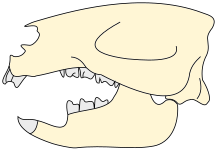Gondwanatheria
| Gondwanatheres Temporal range:
| |
|---|---|

| |
| Skull of Adalatherium | |

| |
| Mandible of Sudamerica | |
| Scientific classification | |
| Domain: | Eukaryota |
| Kingdom: | Animalia |
| Phylum: | Chordata |
| Class: | Mammalia |
| Subclass: | †Allotheria (?) |
| Clade: | †Gondwanatheria Mones, 1987 |
| Subgroups | |
| |
Gondwanatheria is an extinct group of
Classification

For several decades the affinities of the group were not clear, being first interpreted as early
There are three known families within Gondwanatheria. The family Sudamericidae was named by Scillato-Yané and Pascual in 1984, and includes the vast majority of named taxa. The family Ferugliotheriidae was named by José Bonaparte in 1986, and includes one genus, Ferugliotherium, and possibly a few other forms like Trapalcotherium from the Late Cretaceous of South America. Ferugliotheriidae are considered the most basal gondawanatherians, and are sometimes recovered outside the group.[5]

Further fossils have come from India, Madagascar and Antarctica. A possible Ferugliotherium-like species occurs in Maastrichtian deposits of Mexico, extending the clade to North America.[12]
The youngest gondwanatherians are known from the
Biology
Gondwanatheres known from cranial remains almost universally have deep, robust snouts, as befitting their specialised herbivorous lifestyle.
An articulated specimen found in the
The fully described animal, now named
Taxonomy
Order †Gondwanatheria[16][17] McKenna 1971 [Gondwanatheroidea Krause & Bonaparte 1993]
- ?†Allostaffia[3]
- †Adalatherium
- ?†Galulatherium
- Family †Ferugliotheriidae Bonaparte 1986
- †Vucetichia gracilisBonaparte 1990]
- †Trapalcotherium matuastensisRougier et al. 2008
- ? †Magallanodon baikashkenkeGoin et al. 2020
- †
- Family †Sudamericidae Scillato-Yané & Pascual 1984 [Gondwanatheridae Bonaparte 1986]
- †Greniodon sylvanicumGoin et al. 2012
- †Vintana sertichiKrause et al. 2014
- †Dakshina jederiWilson, Das Sarama & Anantharaman 2007
- †Gondwanatherium patagonicumBonaparte 1986
- †Sudamerica ameghinoiScillato-Yané & Pascual 1984
- †Lavanify miolakaKrause et al. 1997
- †Bharattherium bonaparteiPrasad et al. 2007
- †Patagonia peregrina Pascual & Carlini 1987
- †Galulatherium O'Connor et al. 2019
- †
References
- ^ S2CID 216591096.
- S2CID 14077735.
- ^ a b Chimento, Nicolas; Agnolin, Federico; Martinelli, Agustin (May 2016). "Mesozoic Mammals from South America: Implications for understanding early mammalian faunas from Gondwana". Historia Evolutiva y Paleobiogeográfica de los Vertebrados de América del Sur. pp. 199–209.
- ^ Kraus, David W. (2014). Vintana Sertichi (Mammalia, Gondwanatheria) from the Late Cretaceous of Madagascar. [Lincoln, NE]: Society of Vertebrate Paleontology. pp. 1–2.
- ^ S2CID 230968231.
- ^ S2CID 4395258.
- ^ "Fossil From Dinosaur Era Reveals Big Mammal With Super Senses". National Geographic News. 5 November 2014. Archived from the original on November 5, 2014.
- New York Times. Retrieved November 6, 2014.
- S2CID 43921185.
- ^ S2CID 216650606.
- PMID 32517606.
- ^ SVP 2015[full citation needed]
- S2CID 129493664.
- S2CID 14077735.
- ^ HOFFMANN, Simone, THE FIRST POSTCRANIAL REMAINS OF A GONDWANATHERIAN MAMMAL, October 2016[verification needed]
- ^ Mikko's Phylogeny Archive [1] Haaramo, Mikko (2007). "†Gondwanatheria – gondwanatheres". Retrieved 30 December 2015.
- ^ Paleofile.com (net, info) "Paleofile.com". Archived from the original on 2016-01-11. Retrieved 2015-12-30.. "Taxonomic lists- Mammals". Retrieved 30 December 2015.








